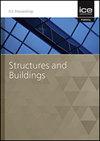Some issues about the behaviour of external pre-stressed steel–concrete composite beams
IF 1.4
4区 工程技术
Q3 CONSTRUCTION & BUILDING TECHNOLOGY
Proceedings of the Institution of Civil Engineers-Structures and Buildings
Pub Date : 2024-02-28
DOI:10.1680/jstbu.22.00044
引用次数: 0
Abstract
A numerical experiment is performed to evaluate the behaviour of externally pre-stressed steel–concrete composite beams (EPSCCBs) up to their ultimate stages, considering second-order effects, tendon material and friction at tendon–deviator locations. The tendon force evolution with loading and slip at the steel–concrete interface is explored. A three-dimensional finite-element model is used to include all these aspects. The idea is to deconstruct the project of eight experimental EPSCCBs with different tendon profiles, considering the above-mentioned issues. The main findings indicate that the inclusion of second-order effects is essential for predicting the stress paths near the collapse loads and slip demands at the steel–concrete interface, while external tendons made of carbon fibre-reinforced polymer (CFRP) can be used as a substitute for classical steel ones, as they presented similar behaviours. The largest tendon force increments occurred for the CFRP tendons compared to other tendons made of glass, aramid and basalt fibre-reinforced polymers. Furthermore, it was found that a friction coefficient between 0.2 and 0.4 at the tendon–deviator interface better matches the available experimental tendon force evolution with loading. This finding seems to counteract the common assumption of using a null friction coefficient as suggested in other works.关于外部预应力钢-混凝土组合梁行为的一些问题
考虑到二阶效应、肌腱材料和肌腱偏差位置的摩擦力,进行了一次数值试验,以评估外部预应力钢-混凝土复合梁(EPSCCBs)直至其极限阶段的行为。研究探讨了钢-混凝土界面上的筋力随加载和滑移的变化情况。三维有限元模型包含了所有这些方面。其目的是考虑上述问题,解构八个具有不同肌腱轮廓的 EPSCCB 试验项目。主要研究结果表明,包含二阶效应对于预测坍塌荷载附近的应力路径和钢-混凝土界面的滑移要求至关重要,而由碳纤维增强聚合物(CFRP)制成的外部筋可以用来替代传统的钢筋,因为它们表现出类似的行为。与其他由玻璃纤维、芳纶纤维和玄武岩纤维增强聚合物制成的筋相比,碳纤维增强聚合物筋的筋力增量最大。此外,研究还发现,肌腱减震器界面上 0.2 至 0.4 之间的摩擦系数更符合现有的实验肌腱力随加载的变化情况。这一发现似乎与其他研究中使用空摩擦系数的常见假设相反。
本文章由计算机程序翻译,如有差异,请以英文原文为准。
求助全文
约1分钟内获得全文
求助全文
来源期刊
CiteScore
3.40
自引率
6.20%
发文量
61
审稿时长
12 months
期刊介绍:
Structures and Buildings publishes peer-reviewed papers on the design and construction of civil engineering structures and the applied research associated with such activities. Topics include the design, strength, durability and behaviour of structural components and systems.
Topics covered: energy conservation, people movement within and around buildings, strength and durability of steel and concrete structural components, and the behaviour of building and bridge components and systems

 求助内容:
求助内容: 应助结果提醒方式:
应助结果提醒方式:


